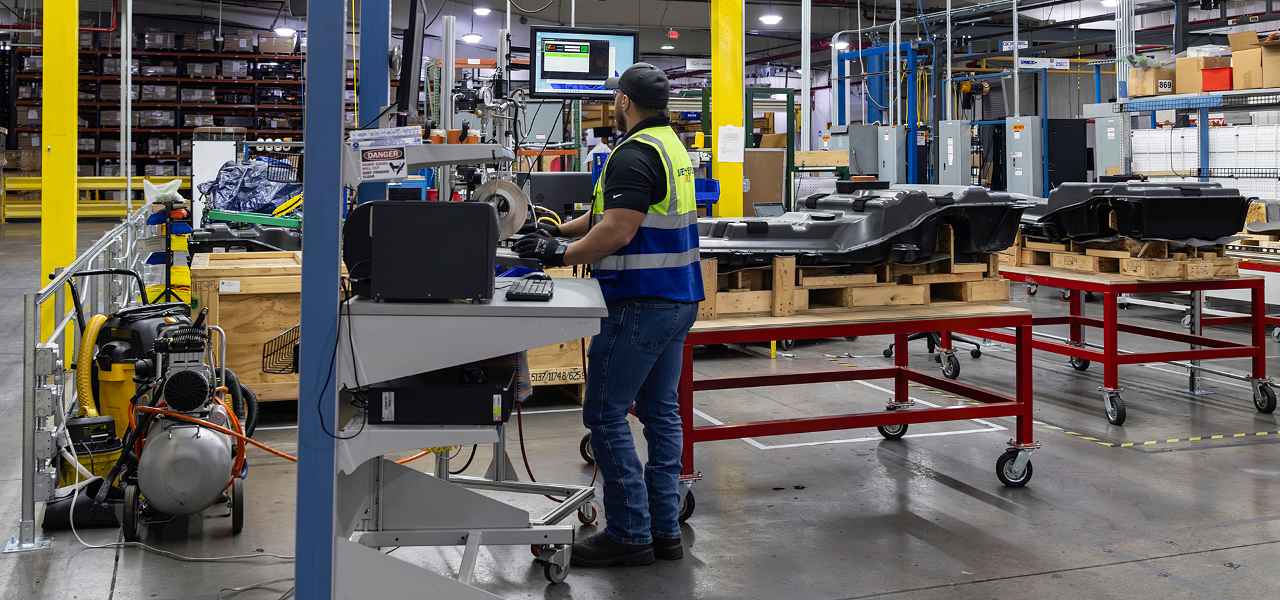 位于俄克拉荷马城的Cox Automotive电池解决方案中心正在处理一家OEM召回的电池,并由一名电池技术人员负责登记入库。(Cox Automotive)
位于俄克拉荷马城的Cox Automotive电池解决方案中心正在处理一家OEM召回的电池,并由一名电池技术人员负责登记入库。(Cox Automotive)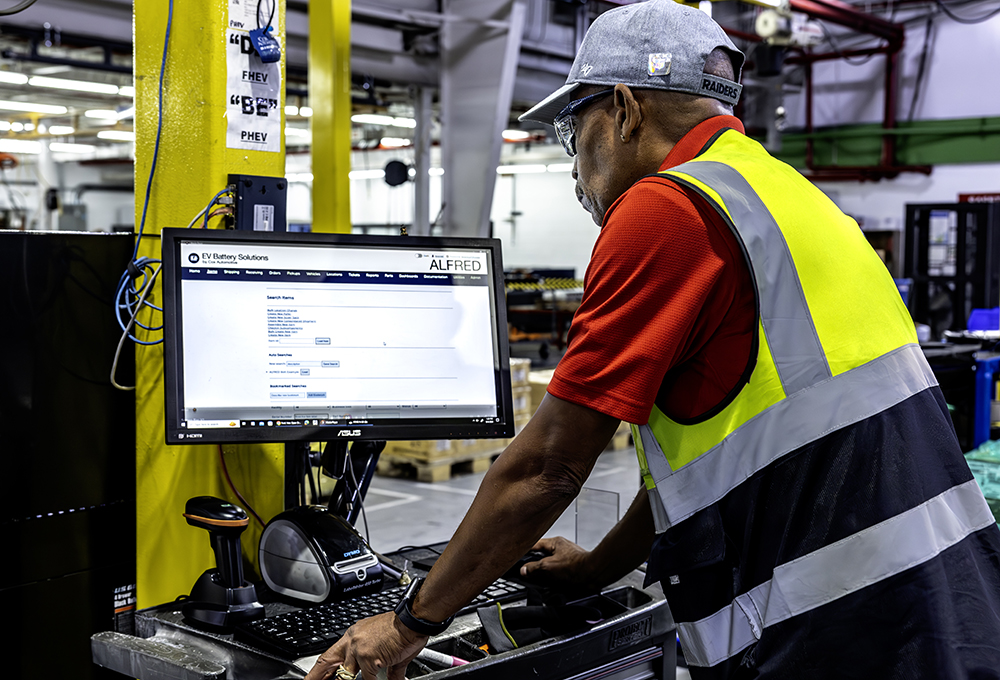
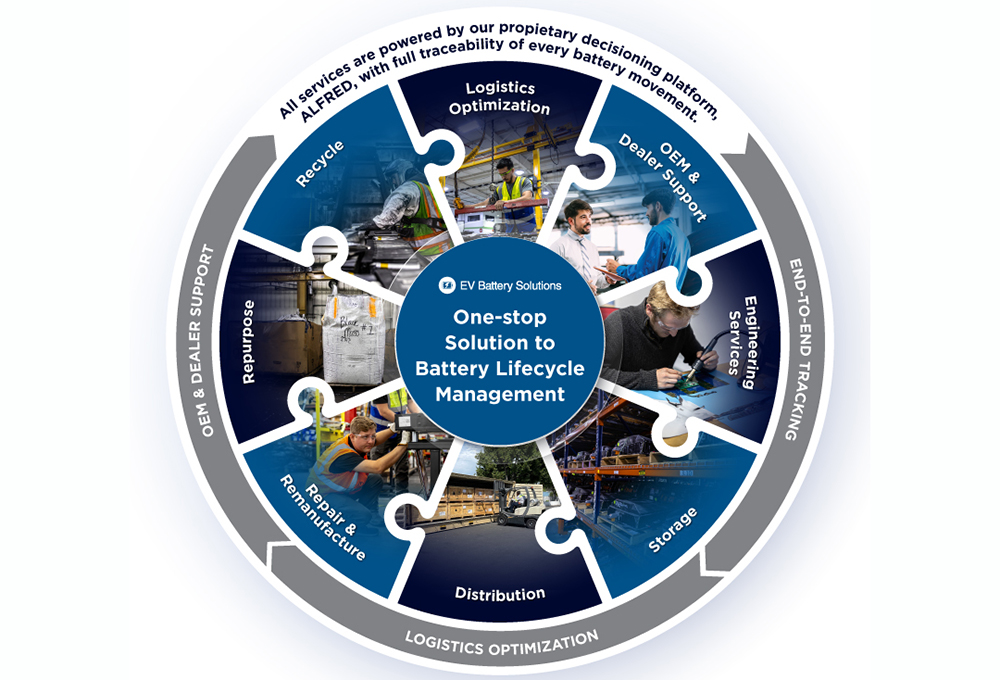
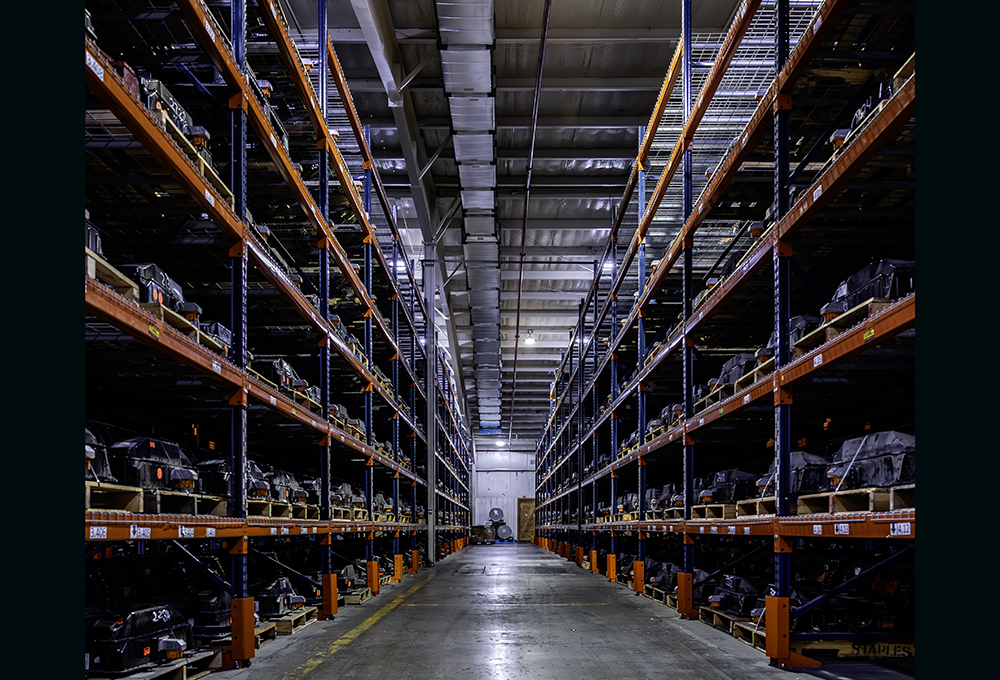
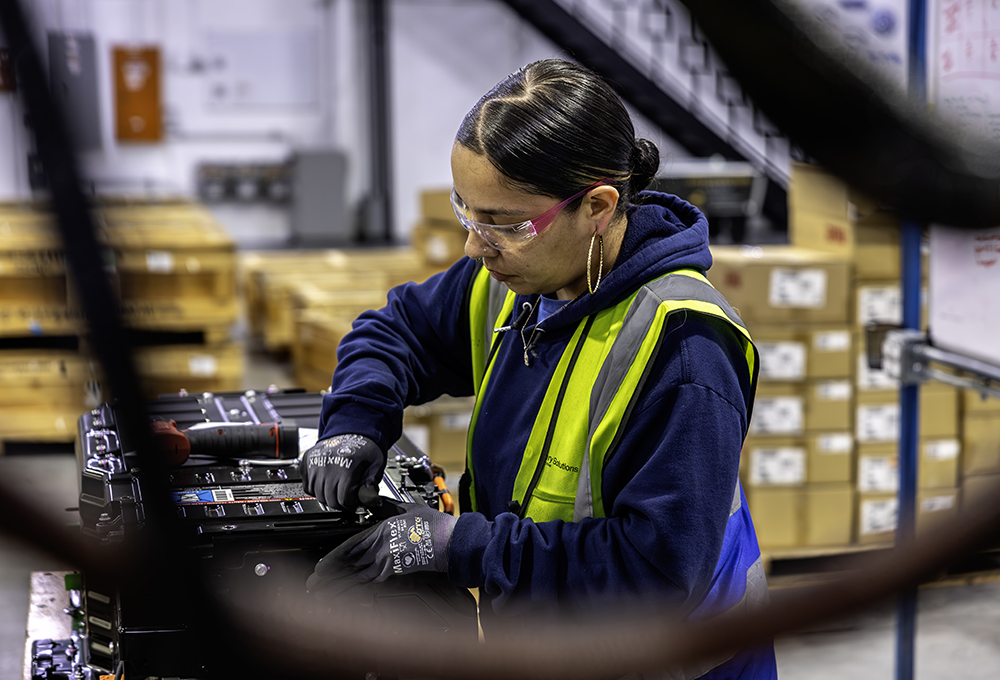
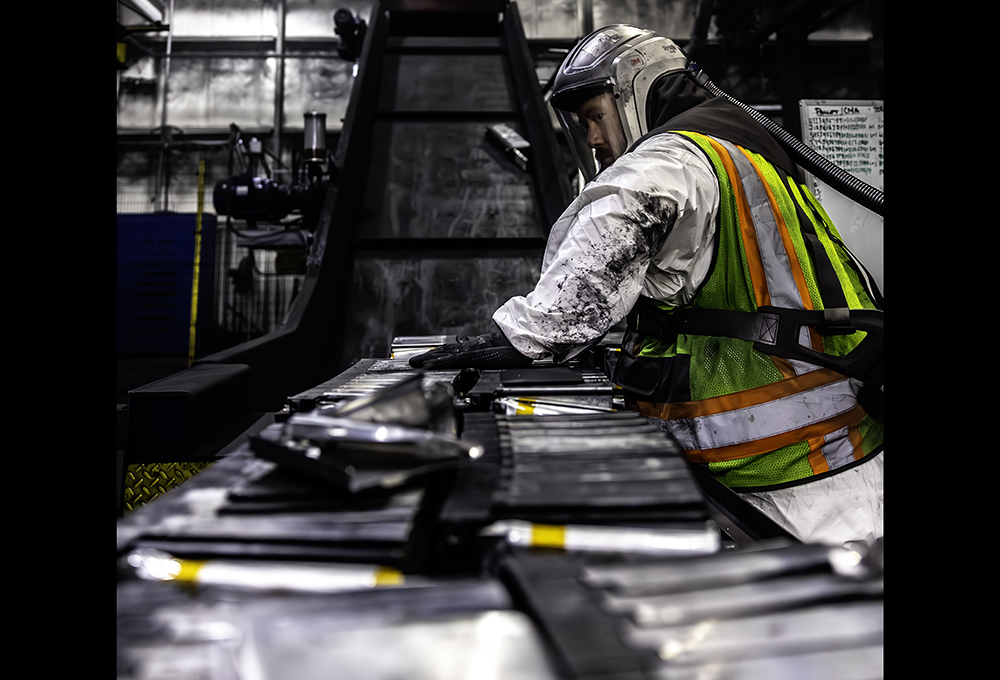 回收室的技术人员穿戴着高度防护的全封闭防护服、头盔和呼吸面罩,因为在粉碎电池的过程中会产生潜在的有害空气微粒。(Cox Automotive)
回收室的技术人员穿戴着高度防护的全封闭防护服、头盔和呼吸面罩,因为在粉碎电池的过程中会产生潜在的有害空气微粒。(Cox Automotive)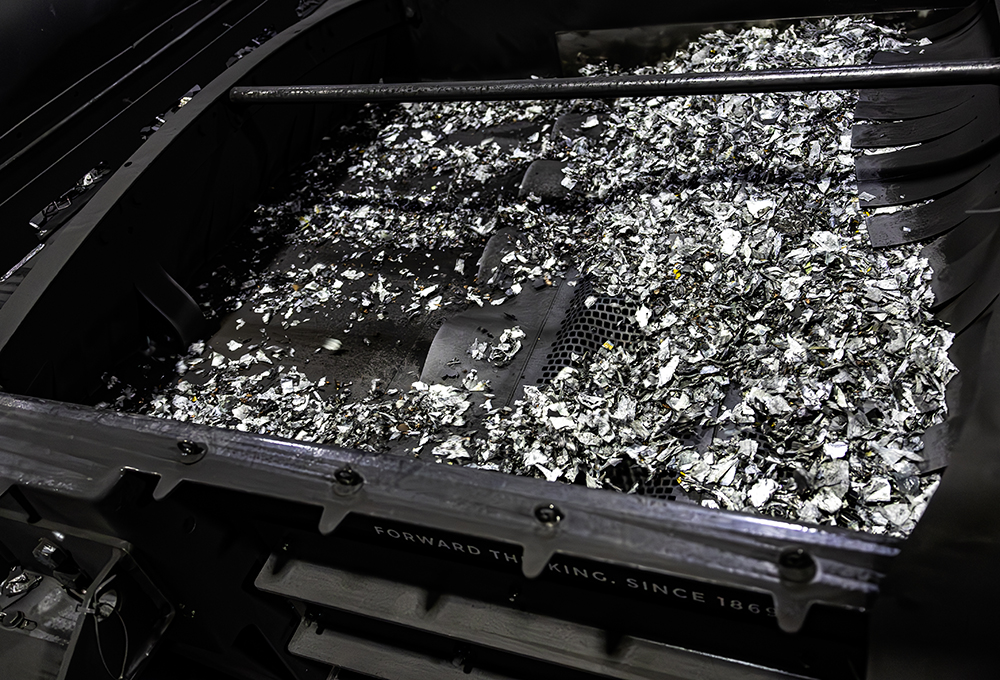 虽然处理的是高科技电动汽车电池,但回收过程是机械性的,相对简单。部件会不断被粉碎,并被分类为成分材料和黑色物质。(Cox Automotive)
虽然处理的是高科技电动汽车电池,但回收过程是机械性的,相对简单。部件会不断被粉碎,并被分类为成分材料和黑色物质。(Cox Automotive)
位于俄克拉荷马城的Cox Automotive电池解决方案中心可以满足OEM的整套售后需求。
位于俄克拉荷马城的Cox Automotive电动车电池解决方案中心已成为电动车电池研究、维修、再制造和回收的首选之地。Cox Automotive是一家坐拥凯利蓝皮书二手车评估(KBB)、Autotrader二手车交易平台和美瀚(Manheim)拍卖公司等著名品牌的大型企业集团。
许多电动车购买者都不曾想过电池还能得到维修。当这些复杂度接近于生物体的动力电池出现问题,经销商的传统维修技术人员往往难以轻松解决。这时候就轮到Cox Automotive的“速派医生(Flying Doctors)”团队出场了,他们既可到现场亲自维修,也可全程指导经销商的技术人员进行维修。
Cox Automotive的EV电池解决方案部门副总裁Lea Malloy表示,电池解决方案业务已开展了11年,其前身是2021年被Cox Automotive收购的初创公司Spiers New Technologies。目前该中心是“覆盖电池全生命周期的首个及唯一的一站式服务中心”。
Malloy尤其引以为傲的是,该公司“曾为全美最大规模的电池召回事件提供了支持”,即参与处理了在2017年至2022年间因火灾隐患被召回的雪佛兰Bolt和Bolt EUV车型的电池。“我们从中积累了大量经验。”
虽然位于俄克拉荷马城的电池解决方案中心的规模最大,但Cox在底特律、拉斯维加斯及其亚特兰大的公司总部附近也设立了维修中心。维修中心在接收和发回电池的过程中拥有一项独特的优势,那就是利用美瀚拍卖公司在145个地区运营的现成的交通运输网络。
Taylor还向我们展示了另一台Cox自主研发的工具——25kW快速放电装置,可帮助回收团队在报废电池前耗尽电池电量。
在电池诊断环节上,根本原因分析工程经理Brandon Carter简要介绍了接收电池后的处理流程。他告诉我们:“电池组外部使用了大量密封胶,所以必须用振动切割工具沿着电池盖切割密封胶,以将其剥离电池组。”打开电池组后,每个电芯都会单独进行测试,以找出损坏的电芯。操作人员必须小心替换损坏的电芯,并确保其与相邻的电芯“匹配”。随后,操作人员需要重新连接母线,并在这个被召回的电池上使用密封胶并拧紧186个螺栓,从而将电池盖再次密封。
在Cox处理镍氢电池的环节上,产品运营经理Sarah Hake介绍了另一种关键组件的非传统获取途径。研究人员需要借助热敏电阻来测量模块温度,但是特定型号的热敏电阻难以获得。经过调查,研究人员发现透析机等医疗设备上使用了类似的热敏电阻。她指出:“我们不需要医用级别的热敏电阻。生产的这些热敏电阻也并非全部达到A级,有些只有B级,但它们的精度已经非常高了,完全能够满足我们的测量需求,而且也很容易获得。”
在回收环节中,耗尽剩余电量和使用多功能破碎机分离电池的过程大约需要三天时间。强劲的空气分离器会将大小不同的材料进行分离,随后电芯和内容物将通过次级破碎机彻底粉碎。在每个阶段中,材料会逐渐被分离成更小的成分,直至一部分材料最终被分离成可再次出售的含阳极和阴极材料的黑质。Cox表示其加工的黑质是市场上品质最好、污染最少的。这一说法得到了合作伙伴Aleon Metals的支持。
“材料会随着传送带转移至后续处理环节。到达指定位置后,它们会被送入多个粉碎装置中。在粉碎材料时,我们会将其处理成所需的大小。我们还采用了一系列分离器,用于彻底分解这些特定大小的材料,以及获得包含高度清洁黑质的材料。”
该回收中心每天最多可处理2000个模块。但工作人员表示,在一般情况下,他们每天大约处理1000个模块。
The company's Battery Solutions Center in Oklahoma City gives company end-to-end dominance in serving OEMs’ post-sale needs.
At Cox Automotive’s EV Battery Solutions center in Oklahoma City, the conglomerate most famous for its KBB, Autotrader and Manheim auction brands, has become a go-to for EV battery research, repair, remanufacturing and recycling.
It's something that not a lot of EV buyers think of. When the complex, virtually living organisms that power EVs have problems, it’s often not a simple fix that can be handled by a dealer’s traditional service technicians. Enter Cox, whose “Flying Doctors” can be dispatched to either complete the repair or walk the dealer’s technicians through the process.
And if the problem is more extensive, a dealer and OEM can send a battery to Oklahoma City, where separate diagnostic and service teams work on the problem. If the battery can’t be saved, it is sent to another end of the compound to be recycled and turned into scrap and black mass that can be used again.
Lea Malloy, Cox AVP for EV battery solutions, said the 11-year-old business, which was Spiers New Technologies before Cox acquired it in 2021, “is the first and only one-stop shop for the entire battery lifecycle.”
Malloy is particularly proud that the company “supported the nation’s largest battery recall,” the fire-related recall of 2017 to 2022 Chevy Bolt and Bolt EUV models. “We learned a lot from that.”
Though the Oklahoma City center is Cox’s largest, they also exist in Detroit, Las Vegas and Atlanta, near the company’s HQ. One unique advantage for the company when shipping batteries to and from repair centers is that it can use Mannheim Auctions’ already-existing transportation network that operates between its 145 locations.
Home-cooked diagnostics
“Battery diagnostics is our special sauce,” Malloy said, referring to the electronics lab, which researches batteries and determines best diagnostic practices. Connor Taylor, the lab’s engineering manager, discussed how the lab has a startup mentality when it comes to engineering and building their own diagnostic tools.
“The testing we need to do with some of these batteries, sometimes there just isn't a commercial option, so we have to build the equipment,” he said. “An example of that is this 800-volt isolated voltage acquisition part. Some newer batteries are 800-volt architecture or higher, and most of the commercial equipment tops out at 600 volts. So, we couldn't really find anything that would fit our needs. So, we had to roll our own.”
He said the other big category of self-built equipment is things that do exist, but there’s a reason for building it in-house. Often, that’s cost. He showed a source measurement unit for testing Toyota Prius and Camry battery modules. Testing involves repeatedly charging and discharging cells while recording voltage, current and temperature. “You can buy off-the-shelf equipment that does that,” Taylor said. “But we calculated that we needed 2,000 channels and were quoted $1,000 a channel. Back in 2018 we didn’t have $2 million to just give to a supplier and wait nine months.”
Cox had a completed design in 2019 but then the chip shortage hit and forced them to design the unit a second time. “That was somewhat of a good thing,” he said, because it allowed them to use newer, better chips. The end cost of the project: A mere $20,000
Among other tools developed in-house is a 25kW rapid discharger used by the recycling crew to deplete batteries before they’re shredded.
Getting inside… safely
Over on the diagnostic line, Root Cause Engineering Manager Brandon Carter gave an overview of the process once a battery is received. “There's a lot of sealant on the outside of the battery pack, so we must use an oscillating cutting tool to go around the perimeter of the lid and peel it from the battery pack,” he said. Once inside, individual cells are tested to find the bad ones. Those are then replaced, with careful attention given to ensuring that they “match” their neighbors before the busbars are reconnected and the lid is once again closed by applying sealant and tightening 186 bolts on this particular battery, which was part of a recall.
A significant part of the team’s attention is on safety throughout the process, including shipping and unpacking defective batteries. “These are one module per box, and when working at this voltage, we use a 40-cal arc flash suit, or what you would probably recognize looks like a bomb defusing suit or a beekeeper suit. It is some heavy-duty stuff, because we want everyone in our facility to go home exactly the way they came here,”
he said. “We want everyone or treat these batteries with utmost respect for the possible dangers that they bring.”
Though a dealer can identify when a battery pack should be repaired, they may not always have the complete data that Cox needs for its Flying Doctors to perform repairs. So occasionally, Carter said, in-depth diagnostics have to be completed on-site and parts have to be shipped before a repair can be completed. “We have to be pretty flexible without schedules when we’re out in the field.”
On the line where Cox deals with NiMH batteries, product operations manager Sarah Hake discussed another unusual sourcing of a critical component. They needed thermistors to help measure module temperatures. But the specific model was hard to come by, so they searched and found that similar thermistors are used on medical equipment like dialysis machines. “We don't necessarily need the medical grade ones. Not everything when they get manufactured is going to be that A-ranking,” she said. “These are actually the B-grade ones. They are still incredibly, incredibly precise, which is good for us, but it also made them very easy to get.”
94% material recovery
In recycling, it’s about a three-day process to ensure battery discharge, then run everything through various shredders. Powerful air separators divides big pieces from smaller pieces, then actual shredders tear the cells and contents apart. At each stage, material is separated into its component parts until eventually part of it is the black mass containing anode and cathode materials that can be resold. Cox says it produces the best, least-contaminated black mass on the market, and the claim backed by partner Aleon Metals.
Tim Harris, the center's director of operations management, said it’s because of the unique, dry recycling process. “Our black mass is shredded in a dry process. We don’t push them down into water to shred them, so we depower [the batteries] to zero before we shred,” he said. “Some other companies run it through a water solution so they can shred live modules. We depower them so they're safe before we shred them. He also said that process is environmentally cleaner.
“It’s traveling up one conveyor. From that point, it moves on to several crushing pieces. When we go to crush it, get it to that particular size we need. We also have a series of separators that actually break down these particular sizes [and] get to what we need to get that really clean black mass.”
Being cleaner is a relative term in battery recycling, though, and it takes effort and consistency to successfully protect workers and the surrounding area. Cox’s enormous recycling room had a gray haze floating in it when SAE Media visited. Thirty-two recycling techs, operating in two shifts, work in fully encapsulated suits and what look like 3M Versaflo air-supply helmets. As for protecting the outside world, exhaust air goes through a series of filters before leaving the building.
The recycling center handles up to 2,000 modules a day, but workers said in a more typical day they process about 1,000.
等级
打分
- 2分
- 4分
- 6分
- 8分
- 10分
平均分
